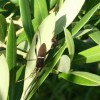 The black scale is an important pest of citrus and olive trees. Originally from South Africa, this scale is now distributed worldwide. In Florida, black scale is found on citrus, cultivated olive, avocado, and many popular landscape plants. It is likely that black scale, like many invasive pests, was imported to the United States on infested nursery plants. Based on their small size and the unique life history of scale insects, these insects are difficult to detect and control. This 4-page fact sheet was written by Morgan A. Byron, Jennifer L. Gillett-Kaufman, and Sandra A. Allan, and published by the UF Department of Entomology and Nematology, March 2015. (Photo credit: Lyle Buss, UF/IFAS)
The black scale is an important pest of citrus and olive trees. Originally from South Africa, this scale is now distributed worldwide. In Florida, black scale is found on citrus, cultivated olive, avocado, and many popular landscape plants. It is likely that black scale, like many invasive pests, was imported to the United States on infested nursery plants. Based on their small size and the unique life history of scale insects, these insects are difficult to detect and control. This 4-page fact sheet was written by Morgan A. Byron, Jennifer L. Gillett-Kaufman, and Sandra A. Allan, and published by the UF Department of Entomology and Nematology, March 2015. (Photo credit: Lyle Buss, UF/IFAS)
http://edis.ifas.ufl.edu/in1082
Tag: Sandra A. Allan
Plagas y Hongos Identificados en Olivos (Olea europea) en Florida
 La producción de olivo o aceitunas (Olea europea) en Florida ha aumentado en los últimos años. La disponibilidad de árboles en los viveros de plantas ha aumentado y muchos residentes los compran para plantarlos en su patio. Afortunadamente, los olivos son una especie relativamente resistente a muchas plagas, pero en ocasiones surgen invasores que pueden causar daños significativos. Algunos patógenos también pueden infectar los olivos y causar enfermedades, reducir los rendimientos o arruinar la apariencia estética de los árboles. Siguiendo las prácticas de cultivo apropiadas para olivos podemos reducir las probabilidades de perder árboles por plagas y enfermedades. Una encuesta realizada con productores de aceitunas en Florida durante el año 2014 identificó las plagas y enfermedades descritas en este documento.
La producción de olivo o aceitunas (Olea europea) en Florida ha aumentado en los últimos años. La disponibilidad de árboles en los viveros de plantas ha aumentado y muchos residentes los compran para plantarlos en su patio. Afortunadamente, los olivos son una especie relativamente resistente a muchas plagas, pero en ocasiones surgen invasores que pueden causar daños significativos. Algunos patógenos también pueden infectar los olivos y causar enfermedades, reducir los rendimientos o arruinar la apariencia estética de los árboles. Siguiendo las prácticas de cultivo apropiadas para olivos podemos reducir las probabilidades de perder árboles por plagas y enfermedades. Una encuesta realizada con productores de aceitunas en Florida durante el año 2014 identificó las plagas y enfermedades descritas en este documento.
This 6-page fact sheet was written by Jennifer L. Gillett-Kaufman, Sandra A. Allan, Jonael H. Bosques-Méndez, and Lyle J. Buss; translated into Spanish by Jonael H. Bosques Méndez, and published by the UF Department of Entomology and Nematology, September 2014.
http://edis.ifas.ufl.edu/in1052
Pests and Fungal Organisms Identified on Olives (Olea europaea) in Florida
 Olive production in Florida has increased over the last few years. As trees become available in nurseries many homeowners are planting them in their landscapes. Fortunately, olives are a relatively pest-free species, but some occasional invaders can be a nuisance or cause lasting harm. A few plant pathogens that may infect olives also can lead to a decline in overall plant health, fruit yield, or the visual appearance of plants. Following correct cultural practices when growing olives can reduce your chances of tree loss from pests and diseases. A survey of olive production and interviews with Florida growers in 2014 identified the pests and diseases described in this 5-page fact sheet, written by Jennifer L. Gillett-Kaufman, Sandra A. Allan, Jonael H. Bosques-Mendez, and Lyle J. Buss, and published by the UF Department of Entomology and Nematology, September 2014.
Olive production in Florida has increased over the last few years. As trees become available in nurseries many homeowners are planting them in their landscapes. Fortunately, olives are a relatively pest-free species, but some occasional invaders can be a nuisance or cause lasting harm. A few plant pathogens that may infect olives also can lead to a decline in overall plant health, fruit yield, or the visual appearance of plants. Following correct cultural practices when growing olives can reduce your chances of tree loss from pests and diseases. A survey of olive production and interviews with Florida growers in 2014 identified the pests and diseases described in this 5-page fact sheet, written by Jennifer L. Gillett-Kaufman, Sandra A. Allan, Jonael H. Bosques-Mendez, and Lyle J. Buss, and published by the UF Department of Entomology and Nematology, September 2014.
http://edis.ifas.ufl.edu/in1046